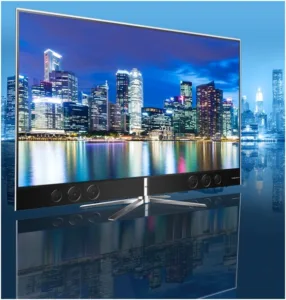I was in the middle of writing this month’s article and came across something very interesting in the current issue of Time Magazine. I decided to shift gear and moved on to write this article instead. I will finish the half done article next month.

 I was reading the November 6, 2017 issue of Time Magazine, which I receive much earlier, as a subscriber. In the center column of Page 18, it shows a picture of Steve Wozniak with the following text.
I was reading the November 6, 2017 issue of Time Magazine, which I receive much earlier, as a subscriber. In the center column of Page 18, it shows a picture of Steve Wozniak with the following text.
“Verbatim. I’m happy with my iPhone 8 – which is the same as the iPhone 7, which is the same as the iPhone 6, to me.”
Steve Wozniak, Apple Co-founder, he’d ‘rather wait and watch’ than buy the iPhone X on its Nov. 3 release date.
Either Steve knows something that no one else knows, or he is not a technology chaser as much as I thought, and considering him as a key technologist. It’s definitely not a price issue. I consider myself to be a technologist, but I still own two Mitsubishi 73” DLP “HD” projection televisions using the wobulation technology developed many, many years ago, and I am perfectly happy with them. Every time I come across a new LCD or OLED television with HD or 4K in the stores or at exhibition, I say quietly to myself “They look really good”. Without having them right next to the television I have, I feel that my “old” televisions look really good, also. I have to say that hidden behind this statement there is a price issue. It does matter.
I own an iPhone 6 Plus, an iPad Pro, a MacBook Air, and an iMac desktop. As a “technologist”, I follow all the new developments of Apple products and watched every Apple event on TV. For the iPhone, I followed the progress and improvements of the iPhone 7, iPhone 8, and iPhone X. There are so many changes and improvements that created so much excitement during the events and afterwards that seem to make the new product a “must have”. The AMOLED in the iPhone X is definitely a big hit and a lot of people are willing to pay a premium for it.
On the other hand, I am still using the iPhone 6 Plus I purchased about three years ago. Besides routine phone calls, emails, messages, camera, and a few other functions, I found that I am probably using about 10% of the functions and capabilities of the device. If I learned more about this phone, my estimate of 10% would probably reduce to 5% or less. I find that most of the new functions and improvements that are presented do not concern me. Without an exception, the increase in processing speed is universal with each release.
One of the main reasons I changed from iPhone 5 to iPhone 6 was the use of GPS and maps. The iPhone 5 was so slow that I could not use the GPS and map effectively. It was actually not usable. When the iPhone 6 came out, I purchased it immediately as the speed was so much faster and the GPS/Map worked perfectly in a “timely” manner and still works now, without needing the increased speeds of the newer iPhones.
I agree with Steve Wozniak. To me, iPhone 7, iPhone8, and iPhone X are “practically” the same. As long as GPS/Map works well, speed to me is not important anymore. All the other functions are fast enough already.
 The iPhone 8 (left) and X (right)
The iPhone 8 (left) and X (right)
What is the case with televisions? What happens to my “old” TV and when should I buy a new TV? Even after I looked at all the new TV’s in the stores, I have not changed my mind yet. Although the new ones look very good, I do not feel that my old TV at home looks any worse. The thickness does not concern me as I have space. My “thin” projection TV sits on top of a stand, in which I have about six items placed, and they have similar depths.
The resolution and brightness of my old TV looks good to me. The 73” size looks especially appealing. I always like big TV’s, the bigger the better. I do not think that my next TV will be anything smaller. However, the most common size these days, is between 55” and 65” and that’s where the cost per sq. in. is the lowest. Larger sizes come with a steep increase in price.
Let’s talk about friends and relatives I have. Beside the people I know within my technology circle, like all of you, almost none of them see the differences in resolutions presented by various TV channels or even in cameras with different resolutions. They are more concerned about having new, thin, and large TV sets than all the other good features that come with them.
Now comes the real question; what would make me and/or Steve Wozniak buy a new television, while we “wait and watch”, literally watch, in this case?
Over the years, I have often talked to people I know, mostly regular people, not “display” people like us, how they decide on what TV to buy. It become quite obvious that the majority of them make the decision based on how much they are planning to pay for the TV and then then get the best TV around the targeted price. They do not want to buy one that is too much cheaper or too much more expensive. The goal seems to be purchasing the “most” TV with the targeted price.
Every item inside the household has a “mental” price that comes from how the buyer was brought up, how much they make, etc. For example, I paid $3,000 for a Macintosh in the early 80’s when it first came out. But, I would not pay more than $1,000 for any computer for my daily use now. I paid a fortune for the 60” Sony projection TV in the early 90’s, but I would not pay the same for any TV these days. With my small budget years ago, I purchased a 19” color TV, not made by Sony, instead of a much larger and better 36” Sony TV.
With the advance in technical knowhow and manufacturing efficiency, the prices of manufactured goods have been dropping.For example, a $4,000 TV of a couple of years ago can be purchased for $2,000 and at the same time, it will have many more features and functions. As a result, the consumer will be able to purchase a lot more technology at the target price or below that target price.
Many new features and functions are included in the new TV’s without significant increase in prices. The consumer can end up with a “vanilla” TV together with a lot of unneeded “flavors” even though it is the vanilla TV that they are looking for. For example, the Mitsubishi projection TV I have is 3D compatible. I did not need it, but it did not come without this feature.
A friend of mine has a 3D LCDTV and he purchased four sets of 3D glasses for the whole family. He told me that they only used it once when the TV was new, watching a demo video of some kind. I believe that the cost of adding such feature is so low that it would cost more to come up with a separate TV model without 3D. By adding more and more features at virtually “zero” cost, the TV manufacturers should be able to target different markets and consumer requirements with the same product. Most of the time, disabling some of the features based on the targeted market also adds cost. Instead, the consumer is asked to navigate through the complicated manual to find what they need and would be able to find their desired features from the larger set of features provided, as no one product will satisfy every consumer’s needs.
Back to the iPhone
In terms of prices, the iPhone X with OLED display costs a couple of hundred dollars more than the iPhone 8 with LCD display, about 25% more. On the other hand, an OLED TV in the 55” range costs more than twice the cost of a standard LCD TV, which is in the thousands!! Choosing an OLED is not likely to be a simple decision for almost anyone. Most likely, the high price is due to the yield of the OLED display. The larger the display, the lower the yield resulting in a much higher cost premium for larger displays.
How many people would be willing to pay several times higher for an OLED TV instead of an LED LCD TV? It remains to be seen how many make the decision, especially where there will be severe competition from quantum dots backlights, where the colors are extremely good. As the LCD technology remains the same and the change from standard LED to quantum dots LED, these sets should carry a small premium only. The LCD TV can further be improved with a higher premium price using microLED technology as the backlight allowing high dynamic range, higher contrast ratio, etc. The quality/cost will be determined as the microLED technology advances.
A Look Back at Plasma
The obsolescence of plasma displays, which have been replaced by LCD displays, might be an appropriate reference for OLED in terms of investment into the new technology. It needs a market, and a sufficiently large market, to attract large amount of investment in manufacturing. LCD displays were initially made in relatively small sizes with very large volumes, fueled by the computer industry and by demand for small TV’s. Although LCD’s were visually less appealing compared to plasma displays, it was a captive market for smaller displays and at the time, large LCD TV’s were very expensive.
Prices of LCDs fell very rapidly because of the increases in volume production. One of my “non-technical” friends, who was quite well off, purchased the best 42” LCD TV made by Sharp some years ago and paid $6,400. About a month later, the price dropped to $4,500. (Because of the short time lapse, he was able to demand a refund of the balance)
The major applications that provided the high volume LCD market were notebook computers and computer monitors, as well as small TVs. With such investments, the quality of LCD displays improved to such an extent that “normal” people could not know/see the difference or imagine that they need a better image. I have a very “technical” friend who knew the high image quality of plasma and purchased one of the last few plasma TVs made by Panasonic, a few years ago. He really enjoys the color and contrast, which according to him, is much better than any LCD TV he has ever seen.
OLED
In the case of OLED, the situation is very similar. Although Samsung’s OLED revenue is increasing while the LCD revenue is decreasing in the third quarter according to the article in Display Daily, deviating from the 50:50 split, I believe that the smaller displays are moving from LCD to OLED as the premium for better quality is smaller and more affordable and the larger display will take some time to catch up with the lower cost difference.
Now comes the iPhone X. There will be significant revenue coming to the OLED makers from Apple, at least for a couple of years, as the iPhone X increases its market share. It will be the quality of the OLED that should capture high-end consumers initially, until the price drops and for there to be an insignificant premium when the technology will spread to the rest of the population.

